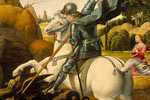

Juliet declared that the primary characteristic of the Fourth World was that it was a place of "Music, Art and pure enjoyment." This is a direct quote from real life.
When Juliet met the Riepers, she stated: "Oh, I adore everything to do with the Arts." Again, in real life, the two girls contemplated the Arts and their talents as Artists extensively.
The girls are shown making models in Juliet's bedroom in "The Donkey's Serenade" sequence. They are dressed in school uniforms and they are making human figures and horses.
Juliet is also shown making figures in the TB sanatorium, specifically, Diello.
Pauline was shown making plasticine figures of Borovnian characters in her bedroom out back. She is dressed in her school uniform, and John(Nicholas) admires her craftsmanship. Pauline tells him that Juliet made 'Gina'.
In real life, it appears as if Pauline was the instigator of the plasticine models of Borovnian characters, though Jackson insists there were also models made by Juliet on the mantlepiece at Ilam.
Juliet displayed Borovnian models in her bedroom, on her bedside table. We see them in several scenes, though the figures and their positions change from scene to scene. For example, the figures are prominent by Juliet's head during the "birth of Diello" scene and later in the "Loveliest Night of the Year."
Juliet also displayed Borovnian figures by her bed and on the windowsill in the sanatorium. Diello was there, in a trinity.
Pauline displayed her large collection of Borovnian figures on the window sill of her outside bedroom.
When she was moved inside, Pauline took her Borovnian figures with her, but they were not displayed as prominently. There were some on her desk and some on her bureau.
This reference to woodworking was taken directly from Herbert Rieper's trial testimony.
 |
|
Rahpael's attempt.
|
 |
|
Juliet's far superior version.
|
Pauline told her: "I think your drawing's fantastic!" Or, more precisely, "I thunk your drawering's fentistuc!" (see 3.1.4.4). [sb]
Juliet's rendition of the legendary scene bears a striking resemblance to one painted by Raphael around 1306 (and currently on display in The National Gallery in Washington). In this rendering, the dragon is very sinuous and reptilian, low to the ground and coiling around the horse's legs and St George has speared its neck with a lance. Raphael's version may seem the more noteworthy effort, but then again, Juliet's version has Mario Lanza. [am]
According to local legend, heard by me as a wee lad, St George slew the dragon on the flat-topped 'Dragon's Hill' at White Horse Hill, near Wantage, in what was then Berkshire but what is now part of Oxfordshire, in England. Probably coincidentally, though with Jackson you never know, but 'Dragon's Hill' is just a few miles away from Aldermaston (see 3.2.2, 7.10.1) [jp]
White Horse Hill is part of a ridge known locally as the Ridgeway after an ancient track that runs along it (I am not sure of the official name for the ridge). The association comes from the fact there is a chalk figure on the side of White Horse Hill (hence the name) which has a long neck and a long whiplike tail. So although it is commonly thought to represent a horse it could perhaps be a dragon. Another local legend says that the bald patch on Dragon Hill where grass nevers grows (which really is so) is due to the blood of the dragon poisoning the ground at that point. [kc]
In real life, horses figured quite prominently in the case and in the real-life writings of Pauline (see 7.4).
To my eyes, Pauline's painting was drawn in a similar style to the Bayeaux Tapestry (sp?)--you know the one celebrating "1066 and All That," [My favourite history book. It's no wonder I didn't excell in History. jp], the one with Halley's comet flying over severed heads and other glorious carnage of William the Conquerer's doing.
We get our first good look in Pauline's room outside after Juliet develops tuberculosis. On her wall are pictures of Mario and Mel, a brown horse head (which migrates around the room from scene to scene) and a pencil drawing of a rearing horse along with other pictures of dancers.
Later, when John(Nicholas) is caught in her bed, there is a picture of a pair of horses going in opposite directions above Pauline's head, and a picture of Paradise through columns by an old Master.
When Pauline first moves into the house, she puts up a few pictures of golden-haired Juliet on her wall, along with many of the others from her old bedroom. Also, there is now a (famous) photo of (the real) Juliet smiling and posing in a bed of daffodils (actually in the gardens of Ilam and much reproduced in true crime books) above the head of Pauline's bed. And there are lots of pictures and portraits and photos of the Saints.
By the time Honora and Pauline have their shouting match over the letter from "Old Stew," the pictures of the various Saints have been joined by 5 drawings of Juliet plus the photo of Juliet. There are now 14 pictures in all on Pauline's walls.
In the final scene in Pauline's room, the morning of the murder, almost all of the pictures on Pauline's walls are of Juliet in various incarnations and all pictures are more and more child-like in their execution, including:
In the first classroom, French Class in early 1952, we see a black & white portrait of King George. He died on Feb 6, 1952. Perhaps this is meant to imply that the opening scenes occurred very early in the year.
In the Geography? class in May '53, the portrait above the blackboard is now a colour picture of a very young Elizabeth II, standard fare for classrooms throughout the British Commonwealth. Especially during the 'Coronation' period depicted in "Heavenly Creatures."

